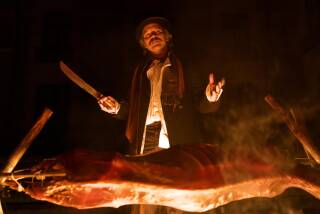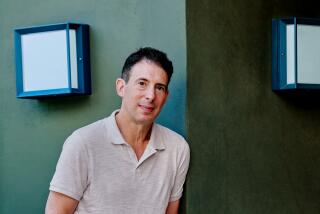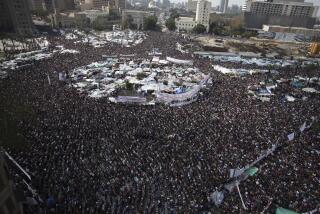Column: What I learned about the pandemic and civil unrest from reading ‘Les Miserables’

- Share via
Reading “Les Miserables” was supposed to be a pleasant diversion.
I thought that, like baking bread or taking long walks, throwing myself into a 1,200-page classic novel would make me feel I was bettering myself and help me pass the pandemic in a manner more rewarding than watching “Veep” reruns over a bowl of Doritos. I expected it would whisk me away from the unpleasant present, and that I’d become absorbed in a melodrama I would be unable to put down, hopefully finishing it just in time to be vaccinated, should that time ever come.
How was I to know that on Page 894, the eerily apt similarities between 19th century France and the United States today would suddenly become unignorable? No one warned me that disease, unrest, political instability and death — the milieu in which Americans have been living in recent days — were Victor Hugo’s backdrop as well.
Though few people seem to remember this (even though 60 million people have supposedly seen the musical), “Les Miserables” is not about the French Revolution, which began in 1789 during the reign of Louis XVI. Rather, the novel begins several decades later and spans nearly 20 tumultuous years, culminating in the events of 1832 in Paris.
That was the year a virulent epidemic swept through Europe, arriving in Paris in March. Three months later in June, inspired by the rising death count, economic distress and anti-monarchist sentiment aimed at King Louis Philippe, unrest erupted on the streets.
The disease in question was cholera, a bacterial infection usually spread through contaminated water. In Paris alone some 20,000 people died of the disease that year, out of a population of well under 1 million.
Tell me this doesn’t sound familiar: Overburdened hospitals struggled to serve all the sick. Conspiracy theories took root. People believed the deaths were not the result of a disease but of intentional poisoning.
Like today, the disease took a disproportionate and terribly unfair toll on Paris’ poor. Like today, the rich fled the city. Cemeteries were overflowing.
Against this backdrop, the country grew increasingly tense.
“By the spring of 1832, although for three months cholera had chilled men’s spirits and in some sort damped their state of unrest, Paris was more than ripe for an upheaval,” Hugo writes. “The town was like a loaded gun, needing only a spark to set it off.”
The immediate spark was the death from cholera of Gen. Jean Maximilien Lamarque, a member of Parliament who was a fierce critic of the monarchy.
When Lamarque’s body was not buried at the Pantheon with France’s greatest heroes, republicans who hoped for an end to the monarchy took to the streets.
After last year’s Black Lives Matter protests and the storming of the Capitol several weeks ago, it’s possible to recognize our own cities in Hugo’s description of a militarized Paris: “In the Place Louis XV were four mounted squadrons of carabiniers, with muskets and musketoons loaded and full ammunition pouches, ready to go into action with trumpeters at their head,” as well as detachments of the Garde Municipale and a squadron of Dragoons and the 12th Light Infantry.
Hugo writes of the idealists, students and workers who manned the barricades and held out as long as they could against the National Guard, but he also describes the rioters and “authentic evildoers, base mouths that talked of loot.” Shops were shuttered. Hundreds were jailed.
The violence was greater in 1832 than in 2020.
But the sense of “wild exhilaration” was similar.
“Nothing is more remarkable than the first stir of a popular uprising,” says Hugo. “Everything, everywhere happens at once. It was foreseen but is unprepared for; it springs up from pavements, falls from the clouds, looks in one place like an ordered campaign and in another like a spontaneous outburst.”
Most of the book’s major characters — Jean Valjean, Marius Pontmercy, the urchin Gavroche and his sister Eponine, the student leader Enjolras and his compatriots — find their way to the fictional barricade on the Rue de la Chanvrerie, in a tragic and doomed-to-fail stand. Many die (though I won’t say which ones).
Hugo was nuanced on the subject of uprisings. He sympathized with the “glorious warriors” on the barricades that June, but also noted that rebellion can spiral out of control or fail to win popular support. There is always “risk and peril when Utopia takes the form of Insurrection,” he wrote.
Here in the U.S. we’ve seen both the glory and the peril play out in recent months. Black Lives Matter protesters marched for justice, part of a historic movement that may actually lead to meaningful change. But then came the flip side: At the Capitol on Jan. 6, we saw protesters became marauders and rioters.
Hugo warned of this too, when he spoke of the “madness” of “mobocracy.”
When I finally put down the book, what I came away with — beyond the love story of Marius and Cosette and the crime-and-punishment saga of Jean Valjean and Javert — was a reminder that our current problems are neither unprecedented nor insurmountable.
The struggle to do away with the monarchy in France took decades. Years like 1832, when the epidemic raged and the state crushed dissenters easily, were frustrating.
But France, after weathering the 1789 revolution, the reign of terror, the Napoleonic Wars, the restoration of the monarchy and the rebellions of 1830, 1832 and 1848, is a republic today.
I was not exactly diverted by “Les Miserables.” But I was heartened.
More to Read
A cure for the common opinion
Get thought-provoking perspectives with our weekly newsletter.
You may occasionally receive promotional content from the Los Angeles Times.











